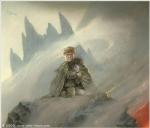Originally Brandywine Productions was approached by 20th Century Fox to create two more sequels. After going through several ideas, David Giler and Walter Hill, the film series producers, "settled upon a complex two-part story that offered the underhanded Weyland-Yutani Corporation facing off with a militarily aggressive culture of humans whose rigid socialist ideology has caused them to separate from Earth's society."[9] Sigourney Weaver (Ripley) would only make a cameo appearance in the third film, with the lead role going to Michael Biehn's Corporal Hicks from Aliens. Aliens 4 would see the return of Ripley "in an epic battle with alien warriors mass produced by the expatriated Earthlings." Weaver in particular liked the Cold War metaphor and agreed to the smaller role.
"I felt that Ripley was going to become a burden to the story." she concluded. "There are only so many aspects to that character you can do."
Weaver also agreed on being removed because she did not like the studio changes to Aliens, which removed scenes of Ripley's backstory that she considered crucial.[10] Although 20th Century Fox were skeptical about the idea, they agreed to finance the development of the story, but asked that Hill and Giler attempt to get Ridley Scott to direct Alien 3. They also asked that the two films be shot back to back to lessen the production costs. However this proved to be difficult as Ridley Scott, though interested, was busy working on three films at the time. In September 1987, Giler and Hill approached cyberpunk author, William Gibson, to write the script for the third film. Gibson, who was influenced by Alien, agreed to write the script
William Gibson
A very early script treatment was written by science fiction author William Gibson. At the time of his involvement, Sigourney Weaver "seemed doggedly unwilling to participate", so the main narrative focus became Hicks and Bishop. The version available on the Internet is, according to Gibson, "about thirty pages shorter than the version I turned in. It became the first of some thirty drafts, by a great many screenwriters, and none of mine was used (except for the idea, perhaps, of a bar-code tattoo)."[11]
In copies of Gibson's treatment, "chestbursters" erupt out of human hosts as in previous installments, and turn into "bigger, meaner, faster" Alien Warriors. However due to initial genetic modification experiments undertaken by the Biological Warfare division on the space station (Anchorpoint), the Aliens additionally exhibit a close proximity airborne virulent contagion. When exposed at close range, the victim, after a variable amount of time goes through "the Change" as Gibson calls it, and becomes a form of alien warrior, the suspense being that the team does not know if anyone is infected until they find out when it is least expected. The process imagined by Gibson can be summarized as an involuntary change in the human's skeletal and muscular makeup below the skin, concluding with the newly formed Alien graphically tearing the flesh husk off of its body. The storyline for the film picked up after Aliens, as the Sulaco drifts into an area of space claimed by the "Union of Progressive People", due to a navigational error. The ship is boarded by people from the U.P.P, who are attacked by a facehugger, hiding in the entrails of Bishop's mangled body. The soldiers blast the facehugger into space and take Bishop with them for further study. The Sulaco then arrives at Anchorpoint, which is a Company run space station/mall. A fire on the ship caused by remaining Aliens puts Ripley into a coma and Hicks is left to investigate if the rumors are true that Weyland-Yutani are developing alien warriors (which they are). The U.P.P. is also doing their own research, due to custody of Bishop. After they have finished with Bishop, they repair him (albeit with cheap parts) and return him to Anchorpoint in a show of good will. Eventually Anchorpoint and the U.P.P stations are overrun with the parasite and Hicks must team up with the survivors to destroy the aliens. The film ends with a teaser for Alien 4 in which Bishop suggest to Hicks that humans are united against a common enemy and they must track the aliens to their source and destroy them. The screenplay was very action oriented, containing 8 marine vs alien battle scenes whereas its predecessor James Cameron's contained only 2 such scenes. It also featured an extended cast with new characters and has a considerable following on the Internet.[citation needed] The producers, while liking certain parts, were unhappy with the screenplay. Gibson was asked to make rewrites with their newly hired director, Renny Harlin, but declined citing various other commitments and "foot dragging on the producers' part."[9]
[edit] Eric Red re-write
The next draft was done by Eric Red, writer of the cult horror films The Hitcher and Near Dark, and opened with a team of Special Forces marines boarding the Sulaco unarmed and finding that all the survivors of the LV-426 mission had fallen victim to the aliens. The only reference to the first two films being a torn spacesuit nametag that is found bearing the name "Ripley". The screenplay in a sense was even bolder than the Gibson script, in that it took place in an entire small-town USA city in a type of bio-dome in space. Red's screenplay resurrected the idea of aliens transforming humans into cocoons that was deleted from the original film. The screenplay's brash storyline culminates in an all out battle with the townsfolk facing hordes of Alien Warriors, yet it also contains an arguably higher level of horror than the previous films and screenplays. It is also the first screenplay in the Aliens genre to feature a genetically mixed Alien-Human creature in antibiosis (foreshadowing the "newborn" in Alien Resurrection). The screenplay also re-uses the "alien virus" idea from Gibson's draft, which this time gives rise to Alien mosquitoes, cattle, dogs and chickens and has even gained the ability to infect matter and technology as well, resulting in the space station itself being transformed into a giant alien-like creature. After being shown Red's screenplay, then-director Renny Harlin walked out on the project to direct Die Hard 2, and Red was fired shortly afterward. It was at this point that Giler and Hill abandoned their plans for the two Alien sequels.
[edit] David Twohy's "Prison Planet"
Writer (and future director) David Twohy was next to work on the project. His version featured a prison planet, which was being used for illegal experiments on the aliens for a Biological Warfare division. The screenplay details how inmates on death row were mock executed in a gas chamber, while actually being kept alive and being used as bait in experiments with the Alien. Examples included breach testing, where the Alien would be videotaped using scientific high speed cameras as it searched for - and found - the weakest part of a structure with a human bait inside, broke through and attacked the victim. This screenplay was also the first to propose a failed clones scenario, describing large jars of Alien test clones, some fused together as Siamese twins, possibly as a forerunner to the "clones of Ripley" scene in Alien Resurrection.
It was also the first script to feature a high number of different Alien types (Rogue Alien, Spike Alien, Alien chameleon, etc.), and was the first screenplay to flesh out the idea of the "newborn" (used later in Alien Resurrection), called the "newbreed" here.
Finally, the script also had numerous scenes where victims are piecemeal sucked into space through a small rupture in the hull (or through bars) causing very gruesome deaths, possibly functioning as a precursor to the death of the "newborn" in Alien: Resurrection.
When new director Vincent Ward told the studio he was not interested in filming Twohy's script and wanted to pursue his own idea of the film, Twohy's draft was scrapped.
[edit] Vincent Ward's "Wooden Monastery"
The story by Vincent Ward and the screenplay with co-writer John Fasano had Ripley's escape pod crash landing on a monastery-like satellite, which had parts of its interior, both, wooden and archaic in design. The Alien 3 special features disc set, Alien Quadrilogy[12] explains how Ward came about creating the story for this partially wooden satellite also as a place of refuge for Luddite-like monks.
The story begins with a monk who sees a "star in the East” (Ripley's escape pod)[13] and at first believes this to be a good sign. Upon arrival of Ripley, and with increasing suggestions of the Alien presence, the monk inhabitants believe it to be some sort of religious trial for their misdemeanors, punishable by the creature that haunts them. By having a woman in their monastery, they wonder if their trial is partially caused by sexual temptation, as Ripley is the only woman to be amongst an all male community in ten years. To avoid this and (hopefully) the much grimmer reality of what she has brought with her, the Monks of the "wooden satellite" lock Ripley into a dungeon-like sewer and ignore her advice on the true nature of the beast.[14] The monks believe that the Alien is in fact the Devil.[15]
Primarily though, this story was about Ripley's own soul searching complicated by the seeding of the Alien within her and further hampered her largely solo attempts to defeat it. The Alien Quadrilogy DVD set features scenes and illustrations that show this ‘Wooden Planet’. Aspects of the monastery and monks of these drafts were later utilised in the final production of the film by having the male inmates participating in an apocalyptic religion that forbade sexual relations. Primarily it was the plot of Alien 3 that was borrowed from this story but little of this world remained in the film. Despite his credit, Ward noted that the things he liked best about the story and those that he believed would have made it work were not used. The screenplay featured scenes set in different locations on the one-mile (1.6 km) wide wooden planetoid, ranging from wheat fields, through a grisly but darkly comic scene in the monks’ communal toilets, to furnaces and a glass works (also used in the finished film).
Empire magazine described Ward’s ‘Wooden Planet’ concept as ‘undeniably attractive – it would have been visually arresting and at the very least, could have made for some astonishing action sequences. In the same article, Norman Reynolds - Production Designer originally hired by Ward - remembers an early design idea for “a wooden library shaft. You looked at the books on this wooden platform that went up and down”. ‘Imagine the kind of vertical jeopardy sequence that could have been staged here – the Alien clambering up these impossibly high bookshelves as desperate monks work the platform’.[16]:156 Sigourney Weaver described Ward’s overall concept as “very original and arresting.”[16]:153 Former Times journalist David Hughes included Ward’s version of Alien III amongst ‘The Greatest Sci-Fi Movies Never Made’[17] in his book of this title. Since Ward’s vision for the film was never borne out into the arena of public scrutiny, this is obviously reserved for those who have taken a particular interest in the Alien project. However, Ward’s proposed version of Alien III has gained a certain following with the 2009 article in Empire Magazine[16] and an extensive section dedicated to Ward’s vision in the Alien Quadrilogy box set.
[edit] Walter Hill and David Giler's Shooting Script
Short on time before filming was due to commence, producers Walter Hill and David Giler took control of the screenplay themselves, melding aspects of the Ward/Fasano script with Twohy's earlier prison planet screenplay to create the basis of the final film. David Fincher did further work on the screenplay with author Rex Pickett, and despite Pickett being fired and Hill and Giler writing the final draft of the screenplay, he revised most of the work done by the previous authors.

 Help
Help





















